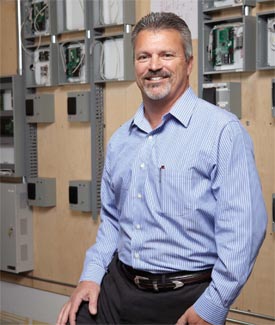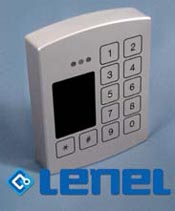Accelerate Your Integrated Security Growth
By Gennifer Biggs, Business Solutions magazine
This solutions provider took several steps to change its trajectory from regional physical security dealer to $25 million integrated security powerhouse.

When Pierre Trapanese bought Northland Controls in late 2005, it was a regional physical security business bringing in about $1.5 million a year. Six years later, the company’s revenues topped $25 million. Achieving that level of success didn’t come easy; rather, Trapanese faced several difficult business decisions tantamount to a company overhaul, that was painful at times, but clearly worth the sacrifice.
Security Success Rooted In Customer Satisfaction
Trapanese is the first to admit that Northland Controls’ customer base already knew what he soon found out after purchasing the company. “Our customers were relatively unsophisticated when it came to technology, but knew enough that they were not happy,” explains Trapanese. “The quality of our work was mediocre at best, and we spent most of our time simply getting our systems to do the most basic functions.” To remedy that situation, Trapanese first took his entire staff to see what a highquality security solution looked like. They visited a Silicon Valley company with which Trapanese had ties (eBay) and while there, he stressed to his team that quality meant more than just installing the right physical security components. It meant attention to detail, innovation, and such small concerns as neatly running cables to and from cameras and other products.
From there, Northland Controls conducted technology audits of each existing customer’s physical security solution, knowing that until the existing deployments were straightened out, no new growth was possible. “We completely focused on our existing customers for the first three months, fixing anything that needed it and sharing with those customers our intent to make their solutions right,” says Paul Thomas, president of Northland Controls Systems. “At first they were suspicious because we weren’t charging for the audits and subsequent fixes, but then when we got their systems working and stable, the trust began to build.” Trapanese notes that while the free system reviews were painful from a cash flow perspective, he felt it was his company’s responsibility to correct those issues. More importantly, he says, Northland Controls’ employees started to gain confidence and enjoy their work again. “When all you are doing is answering complaints from unhappy customers, it’s hard to have good morale,” says Trapanese. He adds that revisiting those customer sites allowed the company to free itself from the quagmire of support issues rooted in improper or poor deployments. With that behind it, the next step was building a team with better skills.
Hiring, Training Leads To Quality Security Solutions
Trapanese found that as he demanded better service and more engagement from the team at Northland Controls, some employees were not as excited about the changes as others, and he faced the challenge of hiring new staff since several original staff members chose to leave the company. “You have to be willing to release those staff not willing to adjust or who are holding the company back,” admits Trapanese. “Even when you have a strong corporate culture, one person can bring the entire team down, and you have to be willing to make that break for the business as a whole.” He adds that while many business owners avoid firing employees, they nearly always know who is dragging the team down, which was the case when he asked one Northland Controls employee to leave. “I wasn’t happy to make that decision, but then the rest of the team actually asked why it had taken me so long; we all knew it was the right choice.”
The staffing challenge faced by Northland Controls in those first few years will resonate with most IT providers; while Trapanese knew who he wanted to hire, he couldn’t afford them. What he did was invest in as much talent as he could afford. “When you are small, you need to hire really good people, and when you do that, you are usually paying them 15% to 20% more, which can be difficult,” says Trapanese. However, he points out that most talented people do considerably better — and more — work, sometimes 100% more than less-engaged staff. Even though Northland Controls was ready to pay a premium for good talent, Trapanese had to uncover other avenues for identifying potential hires rather than poaching the best workers from other security providers. Today, he concentrates on hiring referrals from existing team members, college graduates, and entry-level technicians, then trains them to build a solid team — focusing in particular on project managers and team leadership. In fact, training is another essential part of the process behind building Northland Controls to a multimillion-dollar business; it reinforces Northland Controls’ “no excuses” policy, which stresses that staff always have the resources needed to succeed.
Training efforts are bolstered by its main vendor partner, Lenel, and distribution partner, PSA, as well as local technical universities. Training ranges from technical expertise to management and leadership skills. In fact, several members of the Northland Controls team are currently undergoing American Management Association training. (Learn more at www.amanet.org) “We invest a lot of money in training, but we consider it an investment that we get back every time,” says Thomas. He suggests businesses budget both the time and funds for training on an ongoing basis, admitting that at $5,000 to $6,000 per person/training session, plus time out of the office totaling two to six weeks, training does require dedication by business leadership.
Move Regional Security Business To Global Stage
The first six months of the company’s reorganization were difficult for all involved, but the fruits of their labor were evident in the company’s rapid growth rate. Within two years the company had reached $5 million in revenue. This year, revenue is expected to top $29 million. Trapanese has encouraging words for any small security integrator ready to break out and tackle national or even international growth.
He explains that he had global growth as a goal from nearly the beginning. That goal began to become a reality when Northland Controls first worked with Autodesk and eBay, both of which wanted a reliable local security integrator to secure their headquarters and regional offices. “We started by concentrating on projects within 50 miles of our office, but then, as their security issues expanded overseas, so did our relationship,” says Trapanese. The biggest challenge in that expansion effort? Finding reliable partners to execute projects and support Northland Controls’ customers overseas. While traveling throughout Europe to get acquainted with the global staff and needs of both Autodesk and eBay, Trapanese also conducted interviews with small to medium integrators to find partners to deliver services under the Northland Controls umbrella. That effort was rooted in Northland Controls’ relationship with Lenel (see sidebar), which provided a “starter list” of partners for Trapanese to interview. Today, Northland Controls uses those overseas partners, which operate as subcontractors, to deliver solutions and support to customers in 48 countries. In fact, 90% of its clients have worldwide operations, and in 2011, 32% of Northland Controls’ revenue came from work completed outside North America. The company also has opened London and Singapore offices.
To grow your company — physical security oriented or not — Trapanese has simple advice: jettison your mediocre employees (be honest, you know who they are), invest only in talented people, and spend time on quality. “If you are always going back to service customers or rebuild systems, it will drag you down, and you will never earn their trust.”

